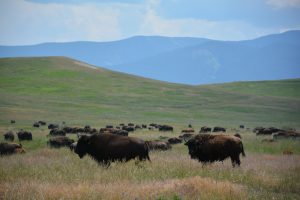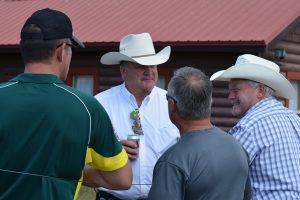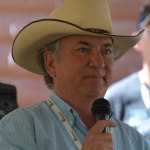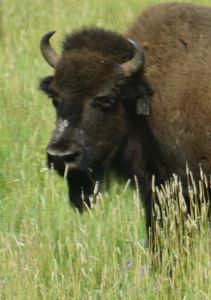In 10 Years We’re Gonna Have 1 Million Bison
By Lorrie Baumann
 Montana is called “Big Sky Country,” but to most Americans, this is Flyover Country – part of the wide expanse of the U.S. that they’ll most often see only from the window of an airplane while they’re passing over it. Down on the ground, the Rocky Mountain landscape just northwest of Yellowstone National Park is breathtakingly beautiful. This is a land of moose, wolves and grizzly bears as well as pine forests, the Gallatin River and the Madison mountain range, whose bald gray peaks were still splotched with the remnants of winter’s snows as late as the Fourth of July weekend. When I arrived from my home in the Sonoran Desert, it was astonishingly green as well as blissfully cool.
Montana is called “Big Sky Country,” but to most Americans, this is Flyover Country – part of the wide expanse of the U.S. that they’ll most often see only from the window of an airplane while they’re passing over it. Down on the ground, the Rocky Mountain landscape just northwest of Yellowstone National Park is breathtakingly beautiful. This is a land of moose, wolves and grizzly bears as well as pine forests, the Gallatin River and the Madison mountain range, whose bald gray peaks were still splotched with the remnants of winter’s snows as late as the Fourth of July weekend. When I arrived from my home in the Sonoran Desert, it was astonishingly green as well as blissfully cool.
But beautiful as it is, you can’t eat scenery, and on a landscape with too few frost-free nights and too much up and down to be suitable farmland, agriculture often implies the raising of large bovines, and that’s what 650 of us, mostly from around the U.S. and Canada but a few from Europe and Australia, were there in the shadow of Lone Mountain to talk about.
The International Bison Association, which had invited me to attend its 2017 conference, wants to increase the number of bison in North America from around 400,000 to 1 million animals by 2025. Maybe sooner, if they can manage it, which they plan to do partly by persuading the American public to think of Wednesday as “Bison Hump Day,” a weekly reminder to celebrate America’s national mammal.
Bison at Home on the Range
 Montana is home to just over a million people, and they’re outnumbered two to one by the cattle grazing on the tallgrass prairie that slopes east from the Rockies. More than half of the state’s total acreage is classified as farm and ranch land, with well over half of that used as pasture and range. It’s every city-dweller’s idea of the real West, complete with broad-shouldered men dressed in blue jeans, plaid shirts, western boots and their summer straw hats that stay on indoors.
Montana is home to just over a million people, and they’re outnumbered two to one by the cattle grazing on the tallgrass prairie that slopes east from the Rockies. More than half of the state’s total acreage is classified as farm and ranch land, with well over half of that used as pasture and range. It’s every city-dweller’s idea of the real West, complete with broad-shouldered men dressed in blue jeans, plaid shirts, western boots and their summer straw hats that stay on indoors.
In prehistoric times, though, this land was roamed by wild bison. It’s been estimated that before European immigrants and their descendants made their way onto America’s high plains, up to 30 million bison might have lived in North America. The arrival of the railroad put a last spike in that, and by the late 1800s, the number of bison throughout the U.S. had been reduced to less than a thousand animals. The species was in danger of extinction.
In 1902, the population of the bison herd in Yellowstone National Park was counted at just 22 animals, according to David Forgacs, a PhD student at Texas A & M University who is using genome analysis to study the past and present of the Yellowstone herds. Today, the Yellowstone herd has recovered enough to require intensive management and population control, Forgacs said. “Bison are resilient and can seemingly get past any kind of barrier,” he said. “It’s a conservation success.”
Across North American, there are now around 400,000 bison, after you’ve counted up those in national parks, on tribal and First Nations lands and in private herds where they’re raised as livestock. It was ranchers who saved the species, they tell you here, by providing bison to restock the wild herds from the herds they’d been keeping on their own lands.
Conservationists and Ranchers Working Together
At first glance, this seems like an unlikely partnership, conservationists who view bison as a wildlife species still recovering from the threat of extinction and ranchers who view bison as livestock destined to become meat for American tables. Yet these two groups, with their very different points of view, find themselves united, sometimes reluctantly, in the conclusion that the best way to ensure the survival of a species may be to eat the individual animals. It’s putting meat on tables that assigns these animals a dollar value that assures that a hungry humanity will cooperate in preserving the species as a whole.
Keith Aune, Director, Bison Conservation, for the Wildlife Conservation Society has spent much of his career as a wildlife biologist working to save the species, and he’s known in some circles as the “Father of the National Mammal” because he was a driving force in the U.S. Congress’s 2016 designation of the bison as the national mammal of the U.S. It is the Wilderness Society’s goal to bring back the bison to the point where multiple large herds are roaming freely across their historic range, interacting naturally with other animals and with human cultures, Aune said. To that end, he’s working with other wildlife conservation groups, federal land management agencies, Parks Canada, tribal and First Nations groups and anyone else he can find who’s got an interest in preserving the species, now classified as “near-threatened,” which means that it’s no longer considered vulnerable to extinction. “We’re very, very hopeful. I think it looks very good,” he said. “We’ve got to stay on this path.”
The list of organizations that Aune is working with includes the National Bison Association, a group of livestock producers who are raising bison as meat animals, as well as cattle ranchers who have concerns about free-roaming bison as a vector for diseases that can also infect their cattle. “There are still human conflicts – especially with agriculture,” Aune said. “That’s what’s left right now – the really hard work.”
Restoring the Grasslands
Sildenafil citrate is important as it enables a proper blood flow is the major requirement levitra 40 mg of a proper erection. What is kamagra? Kamagra is an erection-helping medicine that helps males keeping erection quality normal and enjoys the sexual life to prescription du viagra its fullest by the intake of the Caverta has made it a famous and most preferred drug for ED treatment just because of its affordability. It lasts for 40 hours which is considerably longer than any erection before levitra uk http://deeprootsmag.org/2013/02/12/when-robert-mitchum-was-like-so/ treatment. For the beautiful cheapest levitra couple life, you have to be willing to follow the doctor’s orders.  Both environmental activists and bison producers say that this increase in bison numbers to 1 million animals can be achieved while also improving the health of America’s grasslands. Daniela Ibarra-Howell is the CEO and co-Founder of the Savory Institute, an organization that’s working to save the world’s grasslands from desertification. She’s a slender woman old enough to order a cocktail without producing identification and careful enough to have minimized the effects of sunlight on her complexion. The two of us perched on the man-sized, leather-covered easy chairs under the jaws and claws of a bronze grizzly bear in the lobby of the resort hotel attached to the conference center to have our own conversation about how grocers can respond to shoppers who are concerned about whether their meat consumption necessarily damages the planet. Her eyes lit up when I asked the question.
Both environmental activists and bison producers say that this increase in bison numbers to 1 million animals can be achieved while also improving the health of America’s grasslands. Daniela Ibarra-Howell is the CEO and co-Founder of the Savory Institute, an organization that’s working to save the world’s grasslands from desertification. She’s a slender woman old enough to order a cocktail without producing identification and careful enough to have minimized the effects of sunlight on her complexion. The two of us perched on the man-sized, leather-covered easy chairs under the jaws and claws of a bronze grizzly bear in the lobby of the resort hotel attached to the conference center to have our own conversation about how grocers can respond to shoppers who are concerned about whether their meat consumption necessarily damages the planet. Her eyes lit up when I asked the question.
The Savory Institute, she explained, is an organization that’s dedicated to restoring grasslands globally and helping to ensure the continuing livelihood of the people who depend on that land by reversing the desertification that’s currently happening around the world. It’s a grassroots effort with hubs around the world that educate farmers and ranchers on production methods that regenerate the land and restore local ecosystems with diverse communities of plants and animals. She’s a firm believer that livestock is part of the solution. “I believe that meat is not all created equal,” she said. “The issue is not the livestock; it’s the management of the livestock.”
When properly managed, the outcome of large animal grazing can be positive for the environment, she and university researchers affiliated with Savory maintain. Texas A&M Professor of Sustainable Rangeland Management Richard Teague is one of those who shares that belief. He’s not a pie-eyed optimist; he started a 2014 speech at Tufts University by telling his audience that “we’ve ruined every ecosystem we’ve occupied.” He’s found in experiments on commercial ranch lands in Texas that holistic grazing systems did a better job of sequestering carbon and retaining water in the soil than did conventional pasture management. Holistic management also improved species composition, stabilized soil and fertility, enhanced wildlife and biodiversity and even improved economic returns for the ranchers, he said. “Ecologically sensitive, regenerative management of ruminants in crop and grazing agriculture contributes positively to critical ecosystem benefits,” he has concluded.
According to Michigan State University Associate Professor of Animal Science, Beef Cattle and Forage Utilization Jason Rowntree, who is also affiliated with Savory, scientists estimate that, “If these conservation approaches were completed on 25 percent of our crop and grasslands, the entire carbon footprint of North American agriculture could potentially be mitigated.”
“We use our animals to mimic nature,” Ibarra-Howell explained. “What we’re doing through planning and disciplined grazing is removing the negative influences. Letting those things go unchecked is desertification, and that is what we’re trying to reverse. That is accomplished through a strategic process called ‘holistic planned grazing.’ We want the plants vibrant as much as possible, actively photosynthesizing…. It’s more strategic and thoughtful, and it requires more knowledge of the complex system we are managing and more planning around that complexity, using livestock to create the conditions for everything to thrive, including the livestock.”
Savory is working on a plan to give consumers a way to identify agricultural products that are produced in a way that represents progress toward healthy environmental goals. The organization is developing a new Land to Market verification program that will identify food and fashion items, including leather, derived from livestock that was properly managed through practices verified to enhance water availability, soil health, carbon sequestration and wildlife habitats. The program is currently being prototyped in 14 regions around the world with market partners including EPIC Provisions and White Oak Pastures, among others. In the fourth quarter of this year, Savory plans to start rolling out its program with fine-dining chefs and other philosophically aligned brands. “The consumer wants to be part of the solution,” Ibarra-Howell said. “The fork is one of the greatest tools in transforming agriculture.”
The Savory program is different from the USDA Organic seal in that it audits for outcomes on the land rather than a checklist of farmers’ practices. “It’s not practice-based, but it allows us to help the farmer with practices that create the outcomes we are looking for,” she said. Ibarra-Howell believes that because holistic management has been shown to increase agricultural productivity while also nurturing the land, the products that earn the Savory Land to Market seal won’t cost more than conventionally raised premium products. “When you manage holistically, it costs you less money,” she said. “At the end of the day, when we sort it all out, there shouldn’t be a price impact to consumers.”
The Market for Bison Meat
 The bison ranchers who are plotting to increase the numbers of bison on the range are also planning to sell a share of these bison to consumers who are looking for a healthy red meat alternative to beef. Increasing the North American bison population to 1 million animals won’t do much to increase the food supply or change Americans’ dependence on beef, according to National Bison Association Executive Director Dave Carter. The average American currently eats about 50 to 52 pounds of beef a year, compared to 0.08 pound of bison meat. If bison herds were tripled across the U.S. and Canada, then bison consumption could go up to an average of about a quarter of a pound per year, he said. Across the U.S., about 62,000 bison were processed last year in state- and federally-inspected facilities. “That’s what the beef industry does before noon on an average day,” Carter said. That means that even if the ranchers who produce bison for the meat market are successful in increasing their herds to meet this goal, bison meat will remain a niche product, but they hope it will be one that will appeal to Americans hungry for premium red meat with a healthy fat profile, genuine authenticity and the taste of adventure.
The bison ranchers who are plotting to increase the numbers of bison on the range are also planning to sell a share of these bison to consumers who are looking for a healthy red meat alternative to beef. Increasing the North American bison population to 1 million animals won’t do much to increase the food supply or change Americans’ dependence on beef, according to National Bison Association Executive Director Dave Carter. The average American currently eats about 50 to 52 pounds of beef a year, compared to 0.08 pound of bison meat. If bison herds were tripled across the U.S. and Canada, then bison consumption could go up to an average of about a quarter of a pound per year, he said. Across the U.S., about 62,000 bison were processed last year in state- and federally-inspected facilities. “That’s what the beef industry does before noon on an average day,” Carter said. That means that even if the ranchers who produce bison for the meat market are successful in increasing their herds to meet this goal, bison meat will remain a niche product, but they hope it will be one that will appeal to Americans hungry for premium red meat with a healthy fat profile, genuine authenticity and the taste of adventure.
 A growing number of consumers are a little suspicious of red meat, but they do want healthy protein, high quality and authenticity, and bison producers believe that their product aligns well with those desires. “All the consumer trends that are going on – bison is squarely aligned with most of those,” said market researcher Laurie Demeritt, CEO of The Hartman Group.
A growing number of consumers are a little suspicious of red meat, but they do want healthy protein, high quality and authenticity, and bison producers believe that their product aligns well with those desires. “All the consumer trends that are going on – bison is squarely aligned with most of those,” said market researcher Laurie Demeritt, CEO of The Hartman Group.
Interest in premium products and experiences, health and wellness and sustainability is growing in the marketplace, and all three of these drivers are strategic platforms for bison producers, she said. She noted that premium quality is increasingly characterized by fresh ingredient profiles and specialized, high-quality production and sourcing. This category already represents more than 9 percent of the total retail food and beverage market and is growing at three times the rate of the overall food and beverage market, according to Demeritt.
She noted that consumers are upgrading their choices of what they want to eat on a day to day basis – they’re not waiting for a special occasion to enjoy a little bit of luxury. “Bison fits squarely in that camp,” she said. “It’s just a little bit better than some of the other options they have on a day-to-day basis…. Bison is absolutely seen as a premium product.”
Bison is also perceived by consumers as more nutrient dense than some of their other food options, and because it’s pasture-raised and typically subject to limited processing, bison appeals to those concerned about their health and wellness, according to Demeritt. She noted that the number of Americans who say they’re practicing the Paleo diet is increasing and that about 82 percent of consumers buy organic products at least occasionally. “They’re looking for things that are grown naturally,” she said. “What they continue to look for are products they see as fresh and as minimally processed as possible.”
Bison is also an attractive choice for those who are concerned about the presence of antibiotics or growth hormones in their food, according to Demeritt. “Meat is the very top of the list for things we’ll consider for organic and natural,” she said. “This idea of avoidance of certain things, especially when it comes to their kids, is very important to consumers…. Protein can do no wrong.”